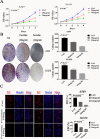Antitumor effect and molecular mechanism of fucoidan in NSCLC
- PMID: 33430854
- PMCID: PMC7802245
- DOI: 10.1186/s12906-020-03191-0
Antitumor effect and molecular mechanism of fucoidan in NSCLC
Abstract
Background: Fucoidan, a water-soluble polysaccharide, exerts anticoagulant and antiviral functions. It was recently reported that fucoidan also exerts an antitumor function. Lung cancer is one of the most common cancers in the world. The aim of this study was to investigate anti-tumor,apoptosis and anti-metastasis effects of fucoidan in both cell-based assays and mouse xenograft model, as well as to clarify possible role of m-TOR pathway in the protection.
Methods: In vitro: Different concentrations of fucoidan were given to act on non-small cell lung cancer (NSCLC) cell lines A549 and H1650. The effects of fucoidan on cell proliferation were observed by detecting cyclin expression levels, CCK8 and EDU experiments and cloning experiments. The apoptotic level was detected by flow cytometry and the apoptotic protein level was detected by Westernblot. By detecting the expression of adhesion molecules, the expression of matrix metalloproteinase (MMP) family, and Transwell cell invasion and migration experiment, the effect of fucoidan on cell adhesion, invasion and migration was observed. Meanwhile the effect of fucoidan on angiogenesis was observed by detecting the expression of vascular endothelial growth factor (VEGF). In vivo experiment: An animal model of NSCLC cell mouse subcutaneous xenograft tumor was established to analyze the correlation between the consumption of fucoidan and the size and volume of xenograft tumor through gross observation. Through immunohistochemical staining and immunofluorescence double staining, ki67 and cell adhesion molecules (E-cadherin, N-cadherin and CD31) and VEGF-A in the tumor were detected, and the correlation between the amount of fucoidan and the above indexes was analyzed.
Results: Fucoidan inhibited the proliferation and angiogenesis of NSCLC cells via the mTOR pathway and promoted their apoptosis by increasing the Bax/Bcl-2 ratio. Not only that, fucoidan inhibited NSCLC cell invasion via epithelial-mesenchymal transformation (EMT). The mice fed fucoidan exhibited significant reductions in tumor volumes and weights. These indicators (Ki67, VEGF-A,N-cadherin) were decreased and E-cadherin expression was up-regulated in A549 mice that treated with fucoidan. The results showed that fucoidan inhibited tumor proliferation in vivo by affecting the expression of related proteins.
Conclusion: Fucoidan conveys antitumor effects and our results represent an ideal therapeutic agent for NSCLC.
Keywords: Fucoidan; Non-small cell lung cancer (NSCLC).
Conflict of interest statement
The authors declare that they have no competing interests.
Figures





References
-
- Siegel RL, Miller KD, Jemal A. Cancer statistics, 2018. CA Cancer J Clin. 2018;68(1):7–30. - PubMed
-
- Ahn JH, Shin MC, Kim DW, Kim H, Song M, Lee TK, Lee JC, Kim H, Cho JH, Kim YM, et al. Antioxidant properties of fucoidan alleviate acceleration and exacerbation of hippocampal neuronal death following transient global cerebral ischemia in high-fat diet-induced obese gerbil. Int J Mol Sci. 2019;20(3):554. - PMC - PubMed
MeSH terms
Substances
LinkOut - more resources
Full Text Sources
Other Literature Sources
Medical
Research Materials
Miscellaneous

